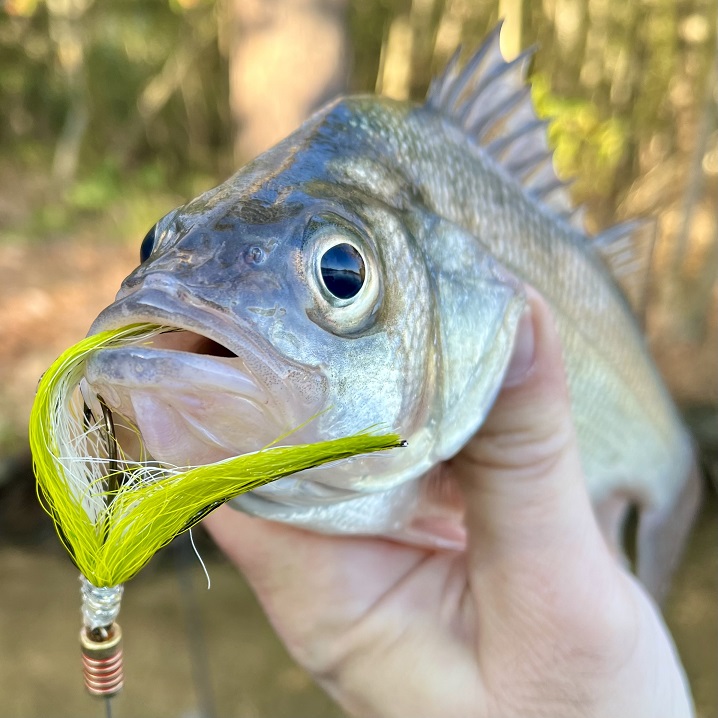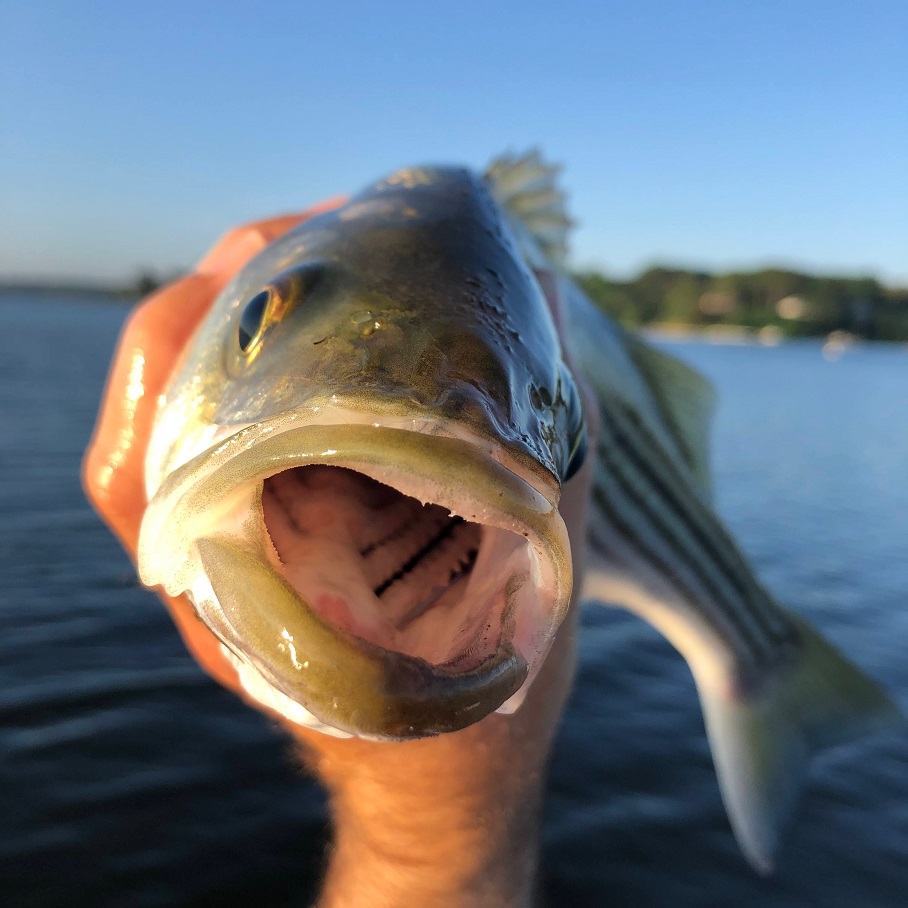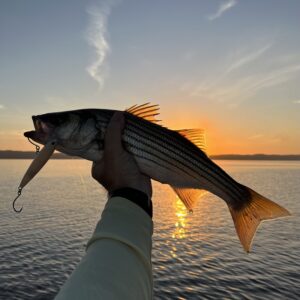Welcome to the Weekly Creel, a compilation of regional news and announcements for anglers and outdoor enthusiasts of the Chesapeake Bay region. Please email us directly at editor@reelchesapeake.com to have your organization’s news item or event listing considered for next week’s column. Per usual, here are direct links to the lastest, local fishing reports from Reel Chesapeake, On The Water, Maryland Department of Natural Resources, Anglers Sports Center, and FishTalk Magazine. The leading photograph (above): Jumbo white perch caught in the Severn Run headwaters last fall. Photo by yours truly.
Severn Headwaters Restoration Begins
This week, the office of Anne Arundel County Executive, Department of Natural Resources (DNR), and the Severn Riverkeeper announced a partnership to clean up the Jabez Branch of Severn Run in the Severn River headwaters. The Resilience Authority will invest more than $8M in grant funding on a long-anticipated project to restore the damaged coastal ecosystem. The project is expected to be completed this fall.
“We are already seeing the consequences of climate change—both environmental and financial—in Anne Arundel County, and we have an obligation to take action now to reduce future impacts,” Anne Arundel County Executive Steuart Pittman stated. “We are grateful to Governor Wes Moore and our state partners for helping us make this project a reality.”
The project, located in Reach III of the Jabez Branch, will help to address a significant erosion and pollution problem that continues to grow. Large sections of the coastal plain have been destabilized and are moving downstream with each rain event—transferring tons of sediment, debris, and pollution into the Severn River. High runoff volumes from roadways and surrounding impervious areas have impacted the headwaters of the Severn River, which once hosted one of the largest perch spawns in the entire Chesapeake Bay.
The approach is to fill the deeply incised channel—10 feet deep or more in places—with native sands, gravel, and wood chips to reconnect it with its floodplain. A series of riffles and pools will be created in the channel to slow the flow and help withstand big storms. The existing 2.6 acres of wetlands bordering the stream will be enhanced and doubled in size. For more information on the project, visit www.ResilienceAuthority.org or severnriverkeeper.org. Photograph by Sarah Caldes, Severn Riverkeeper.
Two Maryland Record Fish Weighed in Ocean City
Cool news from the state’s coast. Two fish were certified this week as record breakers by the Maryland Department of Natural Resources. And both were caught off Ocean City. Angler Chris Stafford of Cherry Hill, New Jersey, caught a pompano dolphinfish (pictured right) weighing 2.0 pounds on September 20th, and Ellicott City resident Stephen Humphrey caught a great barracuda weighing 13.0 pounds on October 6th. Congrats to both anglers!
The pompano dolphinfish was caught in Poor Man’s Canyon, while the barracuda (pictured left) was trolled offshore at Washington Canyon. As a reminder, anglers who think they have a potential record catch should download and fill out a state record application and call 443-569-1398 or email Erik.Zlokovitz@maryland.gov. The department recommends the fish be immersed in ice water to preserve its weight until it can be checked, confirmed, and certified. Photographs courtesy Maryland DNR.
ASMFC Addressing Striped Bass Fishery
The Atlantic States Marine Fisheries Commision is taking additional, and expected, actions to address the dire state of the striped bass fishery, especially in Maryland’s coastal and Chesapeake Bay regions. The Commission’s Atlantic Striped Bass Management Board recently approved for public comment Draft Addendum II to Amendment 7 to the Interstate Fishery Management Plan (FMP) for Atlantic Striped Bass.
The Draft Addendum considers management measures designed to support stock rebuilding by reducing fishing mortality to the target in 2024 and builds upon the 2023 emergency action. Projections indicate that a 14.5 percent reduction in total removals relative to 2022 is needed to have a 50 percent chance of being at or below the fishing mortality target in 2024. For the recreational fishery, the Draft Addendum proposes recreational bag and size limit options for the ocean and Chesapeake Bay regions, including options with different limits for the for-hire modes.
To address concerns about recreational filleting allowances and compliance with recreational size limits, the Draft Addendum includes an option that would establish minimum requirements for states that authorize at-sea/shore-side filleting of striped bass (e.g., racks must be retained). For the commercial fishery, the Draft Addendum proposes a quota reduction option that would reduce commercial quotas by up to 14.5 percent. And the Draft Addendum proposes an option that would enable the Board to respond to the results of the stock assessment updates more quickly, via Board action, if the stock is not projected to rebuild by 2029.
The Draft Addendum will be posted to the website no later than October 31st at asmfc.org/aboutus/public-input. A subsequent press release will provide the details on the public hearing schedule and how to submit written comments. The Board will meet to review submitted comments and consider final action on the addendum in January 2024 at the Commission’s Winter Meeting in Arlington, Virginia.
Nature Preserve Opens in Chestertown
The Sultana Education Foundation held a ribbon cutting ceremony this week for its new Lawrence Wetlands Preserve in Chestertown. Under development since 2017, the Lawrence Wetlands Preserve is an 8.5-acre urban nature center that features a variety of ecosystems including upland forest, swamp, marsh, shrublands, meadows, and a freshwater pond. Located adjacent to the Gilchrest Rail Trail at 301 South Mill Street, the Preserve is within easy walking distance of Chestertown’s Historic District. In addition to its natural elements, the property boasts an accessible trail network, wetland boardwalk, viewing platforms, an activity field, and the 1,200-square-foot Harwood Nature Center.
Beginning in 2024, the Lawrence Wetlands Preserve will host environmental literacy programs and professional development opportunities for 3,000 students and teachers annually, with a focus on PreK through fifth grade. The Preserve will often be used in conjunction with activities taking place at other locations on Sultana’s Chestertown campus, including its LEED Platinum Holt Education Center, the schooner SULTANA, and canoe and kayak trips based out of Wilmer Park.
When not in use for programs, the Preserve will serve as a contact point for the National Park Service’s Chesapeake Bay Gateways Network, host programs for the public, and be open for general visitation daily from dusk to dawn.
The Preserve is named in honor of the late Michael Lawrence, a long-time supporter of the Sultana Education Foundation who was passionate about introducing children to nature. Learn more at sultanaeducation.org.
Calling All Shutterbugs!
The Friends of Blackwater National Wildlife Refuge (NWR) near Cambridge, Maryland, are hosting a digital photo contest now through December 1st to showcase Blackwater NWR and raise funds for Refuge projects. Adult and youth participants are invited to submit photos taken between January 1, 2022 and December 1, 2023, in Refuge areas open to the public, which includes the Wildlife Drive, Marsh Edge Trail, Woods Trail, Tubman Road Trail, paddling trails, the Visitor Center butterfly garden, and Refuge property along Maple Dam Road, as well as the Harriet Tubman Underground Railroad Visitor Center Legacy Garden. The submission deadline is December 1, 2023.
Winners and honorable mentions will be announced in February 2024. First, second, and third place winners will receive monetary awards and will be invited to exhibit framed prints of the winning submissions at the Blackwater NWR Visitor Center in time for the Eagle Festival in March 2024. Participants can visit the Friends’ website for contest details: friendsofblackwater.org/photo-contest-2023. Photograph courtesy U.S. Fish & Wildlife Service.
Twenty-Seven Farms Preserved
The Maryland Board of Public Works approved 27 new Maryland Agricultural Preservation Foundation easements during their October 4th meeting. The easements will permanently preserve 4,600 acres of prime farmland in Caroline, Carroll, Cecil, Charles, Dorchester, Frederick, Garrett, Kent, Queen Anne’s, and Wicomico counties, for an investment of more than $16.9 million.
“Preserving Maryland farmland is incredibly beneficial to its citizens,” said Maryland Department of Agriculture Secretary Kevin Atticks. “By preventing irreversible conversion of farmland to other uses, we protect our local food supply and our local economy. I am grateful to the landowners that volunteered to preserve these 4,600 acres of farmland.”
The Maryland Agricultural Preservation Foundation was established in 1977 as part of the Maryland Department of Agriculture.The foundation purchases agricultural preservation easements from willing farmers to forever protect prime farmland and woodland.
To view a list of the Maryland Agricultural Preservation Foundation easements broken down by county, see this list. The newly-approved easements will help the state meet its newly-enacted goal of conserving 30 percent of state land by 2030. The new goal went into effect on October 1st in accordance with the Maryland the Beautiful Act as passed in the 2023 Session by the Maryland General Assembly.
EPA Announces $10M Chesapeake Investment
This week, the U.S. Environmental Protection Agency Mid-Atlantic Regional Administrator Adam Ortiz announced a nearly $10 million investment into restoring the Chesapeake Bay with projects to be funded by the Bipartisan Infrastructure Law (BIL).
“These projects represent a portion of the generational investments that the Biden Administration is making in the Chesapeake Bay watershed” said Ortiz. “Each one of them will improve not just the local environment where the projects are located, but the Chesapeake Bay ecosystem downstream by removing runoff pollution, cleaning up streams and rivers, and planting native trees and grasses. Four decades ago, visionary leaders set us on a course to protect the Chesapeake Bay. Today, thanks to partnerships like the ones for these projects, we will kickstart the next 40 years of conservation in the Chesapeake Bay watershed.”
Projects will be funded through the Innovative Nutrient and Sediment Reduction (INSR) Program with grants awarded by the National Fish and Wildlife Foundation (NFWF). Since 2006, the INSR Program has provided more than $133 million to 229 projects that have reduced 23 million pounds of nitrogen, 4 million pounds of phosphorus, and 500,000 tons of sediment across the Chesapeake Bay watershed. A complete list of the 2023 Chesapeake Bay Innovative Nutrient and Sediment Reduction grants recipients is available here.
And that’s a wrap for this week’s Creel. If you have news to share, please send an email to editor@reelchesapeake.com.










